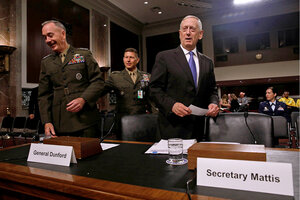Civilian oversight of military: How Trump is testing its minimum levels
Civilian control of the military has been a core US value since the founding of the Republic. In Afghanistan, Syria, and Yemen, Trump seems to be exercising a light touch as commander-in-chief.

US Defense Secretary James Mattis and Chairman of the Joint Chiefs of Staff Gen. Joseph Dunford arrive to testify before the Senate Armed Services Committee on Capitol Hill in Washington, D.C. on June 13, 2017.
Aaron P. Bernstein/Reuters
President Trump is letting the Pentagon set its own troop levels for Afghanistan. He’s given commanders similar flexibility in Iraq and Syria. He’s quickly approved Defense Department plans for counterterrorism operations from Yemen to Somalia.
Do these moves reflect common sense, hands-off management – or a White House that’s too detached from important military decisions?
Since taking office five months ago, Mr. Trump has undeniably exercised a light touch as commander-in-chief. Besides the examples above, he was quick to approve the military’s strategy for firing cruise missiles at a Syrian airfield in response to President Bashar al-Assad’s chemical weapons attack on his own civilians. Trump later said that when he gave the go-ahead for the strike he was enjoying a “beautiful” chocolate cake at his Mar-a-Lago resort.
Now tensions are rising in the Gulf region’s crescent of conflict. In Syria, the US has shot down Iranian-made drones and a government jet that attacked US-backed rebel forces.
Who’s in charge of the US response? The White House, which presumably would weigh diplomatic and geopolitical factors when considering strategy? Or the Pentagon, which institutionally might lean to a forceful response?
“People have new concerns about continued civilian control of the military in this context,” says Alice Hunt Friend, a civilian Pentagon official from 2012 to 2014 who is now a senior fellow in the International Security Program at the Center for Strategic and International Studies.
Civilian control of the military has been a core US value since the founding of the Republic. The Founding Fathers made sure of that. They wanted to avoid the European problem of big standing armies that meddled in politics. So in drawing up the Constitution, they split up responsibility for the military among civilian institutions. Congress has the power to “raise and support Armies” as well as the Navy. The President is commander-in-chief.
The military itself drills the importance of civilian control into its ranks, in part by instilling the concept in cadets at all the service’s military academies.
The issue arose at the beginning of the Trump administration with the nomination of James Mattis as secretary of Defense. Secretary Mattis is a Marine general who retired in 2013; under the law, he required a waiver to serve as the Pentagon chief, a civilian post. The waiver passed Congress easily as most lawmakers saw Mattis as a highly qualified pick for a sensitive post in an administration that has moved slowly to fill many top jobs.
Now the issue of Afghan troop levels has raised the question of civilian control again. Mattis announced at a congressional hearing last week that the White House will allow him to adjust US strength in Afghanistan as he sees fit, to “nimbly align our commitment to the situation on the ground.”
Currently there are about 8,000 US troops remaining in Afghanistan. Commanders have reportedly requested about another 5,000 to bolster this force. It would be far from a surprise if Mattis approves the increase.
The move may be necessary. It is not as if the joint US/Afghan government fight against the Taliban is going well. The Taliban had a good year last year, and are aiming for a good year in 2017, Mattis told the Senate Armed Services Committee in a June 13 appearance.
“We are not winning in Afghanistan right now,” Mattis told the panel.
Trump is right to grant military commanders more autonomy, writes Max Boot, a senior fellow in National Security Studies at the Council on Foreign Relations. During the Obama years the White House micro-managed troop levels and other aspects of the Afghan War, often to the point of frustrating commanders. Now they’ll have the flexibility to react to battlefield conditions, according to Mr. Boot.
“All of President Obama’s secretaries of defense complained about the tendency of relatively junior White House staffers to get deep into the weeds in making military decisions, and about Obama’s tendency to reserve for himself even relatively inconsequential decisions,” writes Boot in Commentary.
But others say that a hands-off approach to military policies such as this is not in the country’s best interests. The number of US personnel sent to fight a foreign war is a matter of great national importance. As such, perhaps it is a decision that should rest with a political leader, accountable to voters.
And Trump’s hands-off approach may inadvertently deepen US involvement in many places. Trump has given the Department of Defense the authority to set troop levels in Iraq and Syria, too, tweets Colin Kahl, who was national security adviser to former Vice President Joe Biden.
US troop levels in northern Syria have doubled, according to Mr. Kahl, now associate professor at the Georgetown School of Foreign Service. US-caused civilian casualties also have spiked. US jets shot down a Syrian attack aircraft on Sunday.
“Seeing a pattern here? Escalation. Everywhere,” tweeted Kahl late Monday.
Ceding power to the Pentagon results in a more Pentagon-centric approach to a geostrategic problem, notes Ms. Friend of CSIS. That’s only natural. To a hammer, every issue looks like a nail that needs to be hit by a couple of F/A-18s or perhaps a cruise missile.
But the military is only one lever of national power, says Friend. Diplomacy is another. So are economic sanctions. Solving a problem like Afghanistan requires the effort of the whole government.
“We wouldn’t want the president to completely outsource strategy to the Pentagon,” Friend says.

